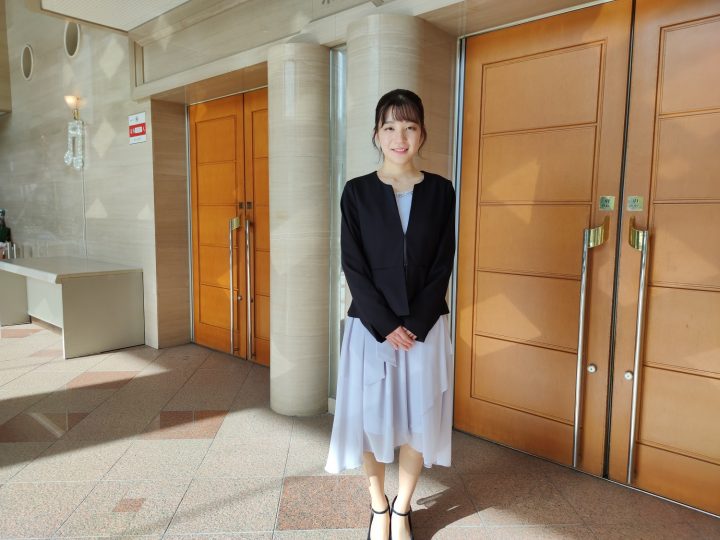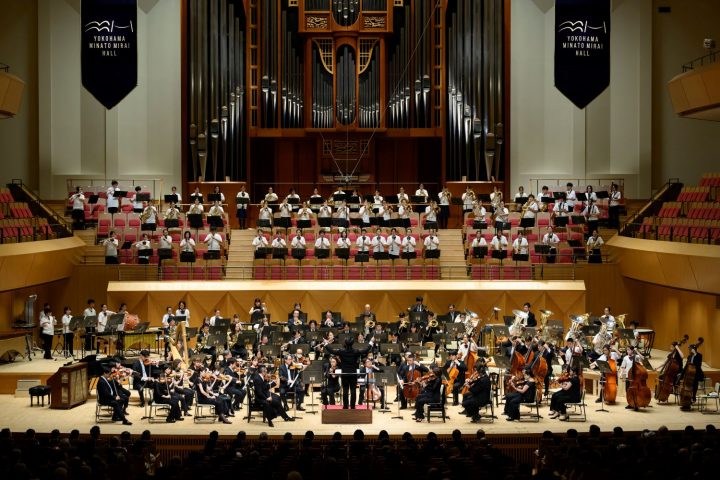Experience the world of drama with the Kanagawa Philharmonic's performance! "Reversal Orchestra Special Concert"
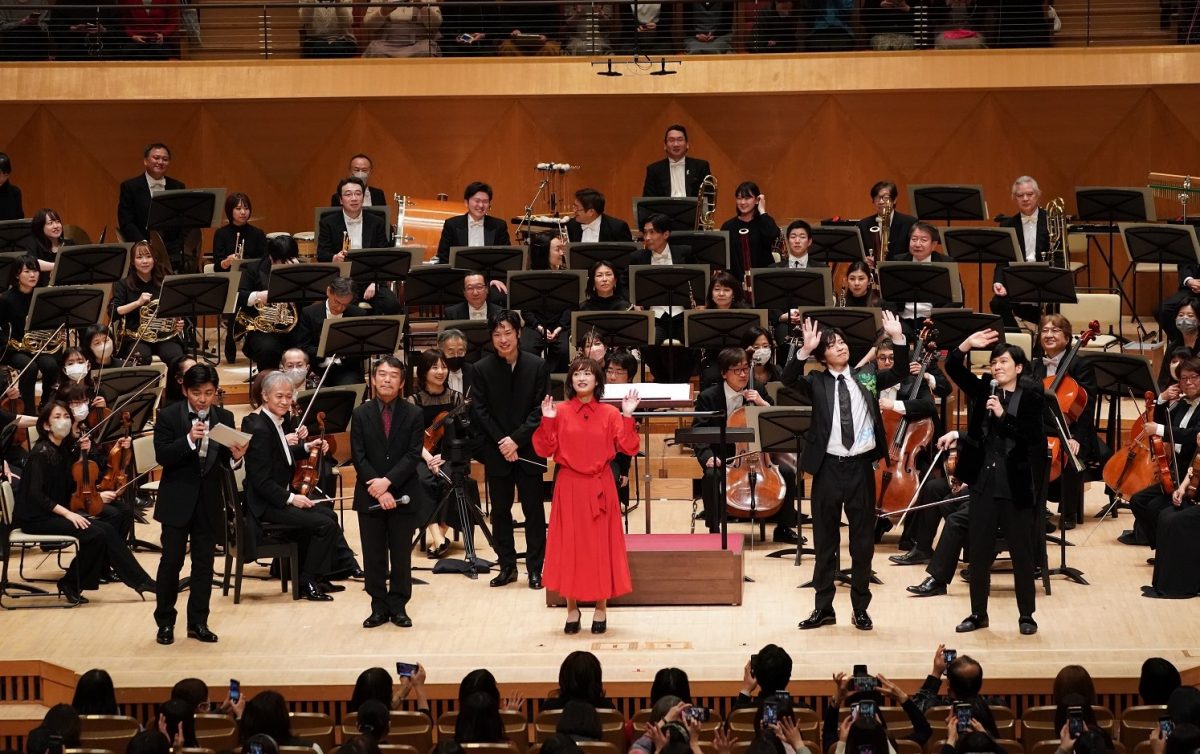
On February 21st, the Yokohama Minato Mirai Hall hosted the "Reversal Orchestra Special Concert," a project for the Nippon Television drama series "Reversal Orchestra." "Reversal Orchestra" airs every Wednesday at 10 PM on the Nippon Television network. It tells the story of former prodigy violinist Hatsune Tanioka, played by Mugi Kadowaki, and up-and-coming maestro Asahi Tokoha, played by Kei Tanaka, as they strive to rebuild the Kodama Symphony Orchestra, a defunct orchestra based in western Saitama City. It's a refreshing musical entertainment that will have you laughing, crying, and feeling energized in the middle of the week, and I look forward to it every week.
The Kanagawa Philharmonic Orchestra (hereafter referred to as Kanagawa Philharmonic) is the driving force behind the musical performances that are the heart of this drama. The Kanagawa Philharmonic not only performs the classical pieces shown in the drama, but also actually appears in the drama as a member of the Kodama Symphony Orchestra (hereafter referred to as Tamayura). This time, we went to a one-night-only special concert where the Kanagawa Philharmonic performed a number of famous pieces, including those that appear in the drama.
As the curtain rose, guest concertmaster Takashi Aoki tuned the instruments. Conductor Kenjiro Sakairi appeared, and the famous phrase "Ta-dah, ta-dah!" rang out throughout the venue. Even though I'm not an expert on classical music, I knew in an instant that it was Beethoven's "Fate." The moment I heard this phrase, all the tension I'd felt about a "classical concert performed by a professional orchestra" was instantly released. Hearing this familiar phrase through a live orchestra was a truly impressive performance, and I began to feel excited, sensing my "destiny" to enjoy tonight's concert.
Next came "Farandole" from the second suite of "Les Amours des Garcons" by Bizet, which also appeared in the TV drama, and Elgar's march "Pomp and Circumstance" No. 1. "Farandole" was the piece that showed off Tamayura's incompetence in the first episode, but at the concert, the Kanagawa Philharmonic Orchestra's superb performance brought a brilliant glow to the venue. The brilliant sound of the flute solo, which was what first attracted Hatsune to Tamayura, captivated the entire audience.
Furthermore, "Pomp and Circumstance" is a song that holds an important position in the drama, as it was the first time that Hatsune Tanioka and Asahi Tokoha performed in front of an audience together with Tamayura in episode 3. The sounds, such as the parts that the troupe members had repeatedly practiced and the climax at the end, evoked images from the drama, allowing us to quickly enjoy the highlights of this concert.
As an aside, Beethoven's "Fate" was first shown (showing a rehearsal) in the drama in episode 7, which aired the day after the concert. Enjoy the music you heard at the concert in the drama, and experience the music you've grown familiar with in the drama live. The program was carefully curated to allow viewers to experience both, and enjoy the drama alongside the music.
After the three songs were played, Kadowaki Mugi and Tanaka Kei, who had been listening to the performance from the audience, came up on stage. Kadowaki commented that she was so moved by the Kanagawa Philharmonic's performance that she burst into tears. Tanaka, who plays the role of a sharp-tongued maestro, said, "I'm surprised you were able to say things like, 'This orchestra is rubbish,' (laughs)," which drew laughter from the audience.
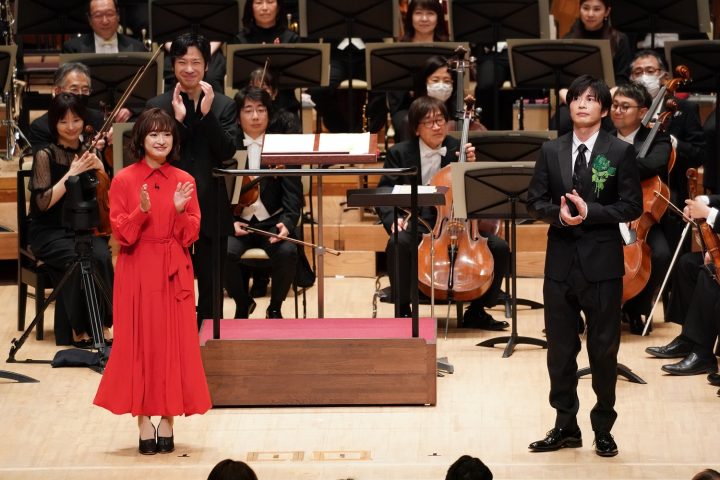
After the two guests took the stage, the audience participated in the "Castanet Challenge," in which they played castanets to the Kanagawa Philharmonic's rendition of "If You're Happy and You Know It, Clap Your Hands." However, this challenge proved far more difficult than expected, and the entire venue was filled with amazement and the clacking of the castanets. Percussionist Mitsuriko Okada, who had wowed the audience with her incredible castanet skills, then demonstrated her "best marimba" skills in Japan with "Flight of the Bumblebee." Her precision and speed made it hard to follow, leaving audiences breathless. Behind the stage, a timpanist and trumpeter performed a comical scene in which they attempted to exterminate a bumblebee by swatting it. This experience reaffirmed the potential of percussion instruments and the friendly side of the Kanagawa Philharmonic.
The packed first part of the concert concluded with Saint-Saëns' "Symphony No. 3 (with organ) - Part 2, 2nd Movement," performed with the pipe organ, which was introduced as "the instrument capable of producing the lowest notes in the venue." Kadowaki and Tanaka were amazed at the size of Minato Mirai Hall's pride and joy, the pipe organ "Lucy." The curtain fell on the magnificent, profound sound of "Lucy."
In the second part of the event, Shinya Kiyozuka, the popular pianist who is in charge of the drama's background music, appeared on stage. After enlivening the audience with his familiar, lively talk skills, he performed a "Reversal Orchestra Improvisation Medley." Kiyozuka's arrangements of classic masterpieces, including "Für Elise," add color to the story and create background music that closely aligns with the emotions of the characters. The familiar classical masterpieces took on a new dimension, and Kiyozuka's captivating fingerwork liberated the audience.

Afterwards, Teiho, who worked on the drama's background music alongside Kiyozuka, appeared on stage and performed "Tamayura Cantabile" with Teiho conducting, Kiyozuka on piano, and the Kanagawa Philharmonic Orchestra playing. It was truly a luxurious moment to be able to enjoy the harmony of the two musicians who worked on the background music and the Kanagawa Philharmonic Orchestra.
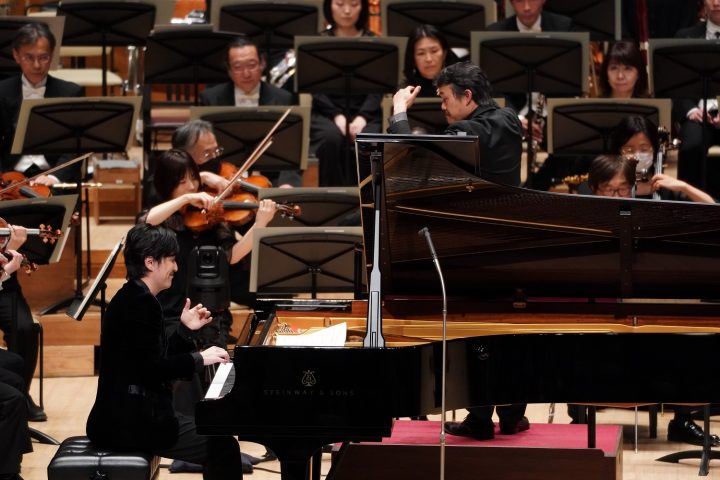
This "luxurious" time wasn't over yet. For the following piece, "Toreador" from the Carmen Suite, Hatsune Tanioka acted as concertmaster and Asahi Tokoha as maestro, transcending the boundaries of the drama. The sight of Hatsune and Asahi shaking hands as concertmaster and maestro was truly moving. Kadowaki's dignified bowing and Tanaka's dynamic yet graceful conducting were truly moving. They blended seamlessly into the professional orchestra, conveying the hard work they've put in to master their skills. Apparently, the actors who perform in the drama had been practicing their instruments since before filming began. The performance scenes in the drama are sure to touch viewers' hearts precisely because the entire cast is so sincerely committed to music. This performance, which blended reality and drama, drew thunderous applause from the audience.
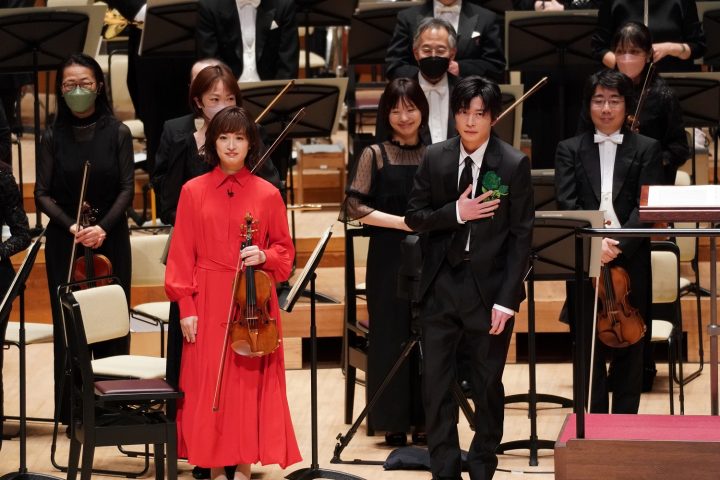
Conductor Sakairi appeared again, and a light-hearted trumpet fanfare rang out. This was "March of the Swiss Army" from the William Tell Overture, which Hatsune performed for the first time with the members of Tamayura. Next was "Mela!", a song by the popular band Ryokuoushoku Shakai, which they performed in episode 4. In the story, this song is also said to have strengthened the bond between mother and daughter, and the beautifully played viola solo brought tears to my eyes.
The final piece played was the fourth movement of Tchaikovsky's Symphony No. 5, which is also the main theme of the drama. This piece, which also serves as the opening theme of the drama, marked the end of the concert. Kadowaki and Tanaka sat in their favorite seats in the orchestra and enjoyed the performance from within.
During the encore, "Radetzky March," the audience spontaneously rose to their feet and clapped along with the guest on stage, creating the most exciting moment of the day. By this point, the feeling "music is fun!" was already overflowing in my heart. Any sense of intimacy I had felt toward classical music, or any anxieties about whether I would ever understand it, had completely vanished. It was a space where you could listen, see, feel, participate, and enjoy yourself to the fullest. And it was everyone on stage and behind the scenes who brought this feeling of "fun" to me.

The members of the Kanagawa Philharmonic Orchestra, who delivered a wonderful sound, were constantly smiling and incorporated a playful spirit to warm up the audience. Conductor Sakairi showed a brilliant smile after each song. Kiyozuka and Teiho's music taught us that "it's okay to enjoy classical music freely." After their performance of "Carmen," Kadowaki and Tanaka commented, "It was fun!" and "It felt great!", embodying the joy of music. The program was filled with the desire to allow even beginners to enjoy classical music without feeling intimidated. Just as each individual note overlaps to weave the sound of the orchestra, the feelings of each individual member piled up to create a wonderful concert.
For me, it was the TV drama that sparked my interest in the world of classical music. Ever since I actually heard a live performance by a professional orchestra, the sounds of the instruments have been ringing in my head ever since. I was completely captivated by "classical music" and "orchestras." Don't be put off by the idea that classical music is intimidating, but definitely go see a Kanagawa Philharmonic performance. Because the door to classical music is wider and more welcoming than you might think, and there's a lot of "fun" waiting for you!
